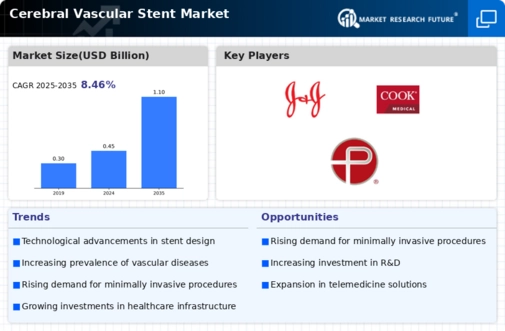Drivers
Rising prevalence of cerebral vascular diseases
According to the American Association of Neurological Surgeons (AANS), stroke, carotid stenosis, vertebral stenosis &intracranial stenosis, aneurysms, and vascular malformations are some cerebrovascular diseases caused by the restricted blood flow to the brain. Blood artery constriction (stenosis), clot development (thrombosis), blockage (embolism), and blood vessel rupture can all cause blood flow restrictions (hemorrhage). Ischemia (lack of blood supply to the brain) damages brain tissue and can lead to a stroke.
According to the World Stroke Organization (WSO)’s Global Stroke Fact Sheet 2019, 13 million new cases of stroke are diagnosed globally every year, and over 80 million people have experienced stroke currently living. According to the report, one in four people will experience a stroke in their lifetime. Cerebral vascular stents are placed appropriately to improve blood flow in the brain and treat or prevent strokes from happening. Therefore, the high prevalence of cerebral disorders is likely to drive the cerebral vascular stent market significantly.
Rising geriatric population
Even though cerebrovascular disorders can occur at any age, from infants to old age people, the risk of getting such a disorder increases with age. Aging causes vascular morphological and functional changes in the brain, making it more vulnerable to cerebrovascular disorders.According to a report published by Mayo Clinic, the US, in May 2019, the most powerful non-modifiable risk factor for incident stroke is aging, and the risk doubles every ten years after the age of 55. Around three-quarters of all strokes occur in those over the age of 65.
The frequency of incident strokes in older persons is likely to increase with the growing population crossing 65 years of age.
According to a report published by United Nations (UN) in December 2020, the older population is growing rapidly due to factors such as increasing levels of life expectancy and decreasing fertility levels; about 727 million peopleaged 65 years or over were living in 2020, and this number is projected to increase to 1.5 billion approximately in 2050. Globally, the population aged 65 years or over is expected to increase from 9.3 per cent in 2020 to around 16.0 per cent in 2050.Hence, the increasing geriatric population will supplement the growth of the cerebral vascular stent market.
Opportunities
Increasing clinical trials and approvals for cerebral vascular stents
The increase in the number of clinical trials for cerebral vascular stents is expected to significantly boost cerebral vascular stent market growth when the regulatory bodies approve the products. Several products are also getting expanded indication approvals. For instance, Stryker’s (US) Neuroform Atlas received expanded indication from the FDAfor use in the posterior circulation applications in the brain.
Several recent product approvals further supplement the cerebral vascular stent market growth. For instance, the Pipeline Flex Embolization Device, by Micro Therapeutics, Inc. (US), a product for treating brain aneurysms, was approved by the FDA in December 2018. FDA approved another product called Neuroform Atlas Stent System by Stryker (US) in May 2019. Furthermore, In December 2019, FRED System, a stent product by MicroVention, Inc. (US), was also approved by FDA for brain aneurysm treatment.
Restraints
Post-surgery complications for cerebral vascular stents
Some of the common issues that can occur during the procedure include an arterial puncture, stent movement, injury to the arterial lining resulting in an arterial dissection, bleeding into the brain, and stroke due to artery obstruction.According to National Heart Lung and Blood Institute, one to two percent of people who undergo stent surgery develop a blood clot at the stent site. However, the benefits of using stents outweigh the risks associated.
Value Chain Analysis
The cerebral vascular stent market is growing steadily due to the rising number of players coming forward with new and better products. The value chain analysis of the cerebral vascular stent market comprises five major components starting with the research & development and designing, followed by manufacturing the products, distribution & sales, and post-sales services.
And lastly comes post-sales services. The post-marketing monitoring stage begins with a periodic safety update report of the product, which is to be submitted to the FDA after the device comes into the market and accounts for around 5% of the value chain. In this step, sometimes product recalls also occur if some long-term issues related to the products are discovered. For instance, in March 2020, FDA recalled Pipeline Flex brain stent products of Medtronic plc (Ireland),citing fracture reports during the implantation procedure.
The increasing prevalence of cerebrovascular diseases is driving innovation and demand for advanced cerebral vascular stents, which are poised to enhance patient outcomes and procedural efficacy.
U.S. National Institutes of Health (NIH)













